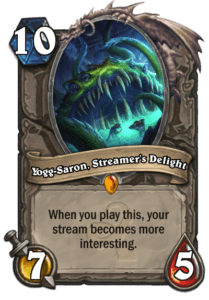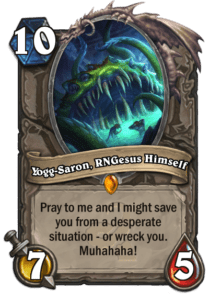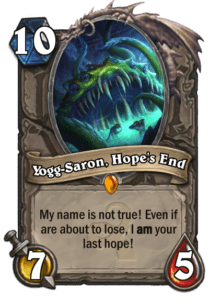
Yogg-Saron Infographic and Analysis (Standard – Kraken)
by OtakuMZ - 8 years ago show comments
Introduction
Yogg-Saron is a very special card. If I had to choose one card to describe what does Hearthstone differentiates form physical card games, this would be it. I also use to call him “Yogg-Saron, RNGesus himself”. Another aspect that Yogg brought to the community is an entertaining one. This card made streams way more exciting. Therefore my second nickname for him is “Yogg-Saron, Streamer’s Delight”.
Besides that, against all odds and randomness, the card is surprisingly good. I will try to highlight why by the means of my usual number crunching and summary of articles the community already produced. All numbers will be presented in an infographic. Anyway, I will do it a little different today. Rather than doing a graphic that lists all spells, the way I did it with the Forbidden Shaping Infographic, I will give you a bunch of charts. Why? Putting all 226 spells in a graphic is a tedious work, that will not be of particular help, because you can’t choose the spells anyway. You can look up all spells easily in your collection or by browsing a site like Searchstone. I also copied my evaluation spreadsheet to google.docs where you can access it, just use the link. I thought it would be better to invest the 4-6 hours it would cost me to align all spells in an orderly fashion, to draw a comprehensive assessment when (or when not) it is favorable to play Yogg-Saron and why.
Yogg-Saron, Hope’s Beginning
Yogg’s title “Hope’s End” could not be more wrong. Most of the times you play this card, the old god is the exact opposite. You want to play it when you are behind on board and/or card-wise, hoping that the random spells will swing the game in your favor. Before I go on, here is an overview in which categories I broke down all spells. There is a total of 226 spells, subcategorized in the following effect types. The absolute number of cards in each category and examples are presented in parenthesis:
- hard removal (14, e.g. Polymorph)
- AoE damage and removal (25, e.g. Flamestrike or Brawl)
- direct damage (32, e.g. Fireball)
- heal / armor (6, e.g. Healing Touch)
- card draw (10, e.g. Arcane Intellect)
- card generation (e.g. Thoughtsteal)
- buff (31, e.g. Mark of the Wild)
- debuff (4, e.g. Hunter’s Mark or Equality)
- secret (20, e.g. Noble Sacrifice)
- summon (13, e.g. Animal Companion)
- other (14, e.g. Shadowform or Shadowstep)
- multiple* (46, e.g. Holy Nova, Blizzard)
* cards with multiple effects: each spell has exactly 2 effects resulting in a total no. of 92 effects for all 46 cards (see separate graph for effect distribution in these spells)
Another categorization I wanted to implement, was to divide spells that can harm you from the spells that don’t, because there is a considerable a risk involved playing Yogg-Saron. You can find quite a few of these classifications on the internet. The one that I found most useful, in comparison to other categorizations into tier Levels e.g t1 to t5, was a risk stratification on the basis of how probable spells are to backfire. I adapted the System I finally used from the Yogg-Saron Card Simulator. As always, a system like that is never perfect and the benefit or drawback of each spell might vary, depending on the circumstances. Nevertheless, I think it provides at least a reasonable approximation of reality. Risk levels are as follows, again, the absolute number of spells in each categorie as well as example are provided in parenthesis:
- perfectly safe (92, e.g. Sinister Strike, Animal Companion)
- probably fine (10, e.g. Shadowflame, Shadowstep)
- risky (89, e.g. direct damage that does not say “enemy”)
- dangerous (4, Astral Communion, DOOM!, Elemental Destruction, Twisting Nether)
- draw cards (15, e.g. Norish)
- probably nothing (16, Bestial Wrath, Shield Slam)
For the ones with multiple, I categorized accordingto the dominant effect, e.g. Shiv was sorted into card draw and not into direct damage. If you are interested in other evaluation systems, you can read for example Strelzik’s post from the Hearthstone subreddit Why you should play Yogg Saron – An in-depth Analysis. He also provides a spreadsheet which you can abuse, but be aware that he forgot 4 spells (don’t remember which ones). He also evaluated card draw regardless the fact that they are drawn from inside or outside your deck. For your convenience, as already mentioned, my spreadsheet can be found here.
When looking at evaluation models, there are a few things to consider, regardless the system used. These might not be obvious in the first place. There are spells that probably do nothing – they just to fizzle. These are spells that need very narrow circumstances to happen, for example Shield Slam, which requires you to have armor, which is unlikely assuming you are not plaing warrior and even more because you are normally behind when playing Yogg. Well at least nothing happened, right? Card draw is a double edged sword. Sometimes you want Yoggi to draw you a bunch of cards. In the fatigue scenario, thinning out your deck is counterproductive and might even lose you the game. In these circumstances, if you have other options available, it might be favorable to hold back Yogg-Saron. Board clears are dangerous, but can turn out well if you are behind on board. There is a good chance though, that the god of death wipes your minions (and himself) too. Therefore, you should probably refrain from playing Yogg if you are ahead on board because it has a high chance to backfire. Some board control tools might affect you less, namely Brawl and Enter the Coliseum (both categorized as risky), but if you are ahead they still will most likely hurt you more than your opponent. Finally, all direct damage effects that to not point to an enemy character, minion or hero (according to the card text) are more or less a coin flip, depending on the board state.
Especially the last point leaves us with a bad gut feeling, isn’t it? In the following chapter, I will show you in the next chapter, right after the infographic, why it shouldn’t. All that I talked about in this chapter is summarized in the “Yogg-Saron Infogrphic” below.
Full RNG or Partly Rigged?
Let’s look at a very interesting experiment performed by user edsmedia from the ComeptitiveHS subreddit. He applied the Central Limit Theorem and discribed the outcome in his post “What Does Yogg-Saron Do? And Is That Good? A Short Monte Carlo Evaluation“. He evaluated the outcomes of 100 simulated games, which I will give you a summary about. He draws a realistic scenario of you being behind: “We’re playing Grinder Mage, it’s turn 20. We have 10 health and have a silenced Brann on board; opponent has 20 health and a 3/2 weapon, a damaged Yeti, a 2/2, a 2/1, a 1/1, and just played Twin Emperors for the double 4/6 taunt. We have two cards (Flamewaker and Sorcerer’s Apprentice) that won’t prevent lethal, and thus need to topdeck something to save us and maybe rescue the game.” The second assumption he made, is that “[…] we have played 15 spells earlier […]”. Comment from my side: being on turn 20 isn’t the most usual, I would have chosen something in between 10 and 15 to be more realistic, but 10+ spells played is not uncommon. This is especially true in mage and druid decks that abuse Yogg-Saron. He rightly points out, that “the only card I could run other than Yogg, that would improve the situation, would be Deathwing” and that “in order for Yogg to be playable, it has to frequently be better than Deathwing”.
For each trial, he “evaluated the resulting game state quantitatively and qualitatively, using the following factors:
- End of game – Did I kill opponent? Did I die? Does opponent still have lethal?
- Face damage/healing to both heroes
- New cards in my card, based on those drawn from deck and also Thoughtsteal, Convert, Burgle, etc. (A few draws is a good thing; 14 is not.)
- My ability to attack with face following the Yogg procs (if rope has not run out…)
- “Who has the board now?” – a qualitative assessment of tempo”
His results were (shortened version):
- Yogg mostly prevents lethal (78%)
- Yogg generally resets the board, often in my favor (8% unfavorable, 40% favorable, 52% even board state with a total of 28% being a full board wipe)
- Yogg is not a finisher (damage to opponents face in 60%, heals in 4%; 0% effects killed opponent).
- Yogg is about as likely to heal and to hurt my face (heal and armor >10 in 34% and <10 in 30%; heals are bigger than damage)
- Yogg adds cards to my hand (95% added cards to the hand, mean 3.5; 10% more than 5 cards drawn and 1% death due to overdraw
- Yogg gives me secrets (76%, mean 1.6 secrets)
- Yogg sometimes lives (58% dead or Shadowstepped)
He concludes that Yogg-Saron, owing the additional card draw and the likelyhood of a more favorable board state than before, this old god is better than Deathwing.
You see, RNGesus is with you! Sometimes…
Outro and Real Life Example
If you have any questions regarding the interactions of YOgg-Saron with other cards, the last link at the bottom of this article should answer all these questions.
As I come to an end writing this article, I wanted to post some in-game screenshots, just to give an impression of what can happen. I did not have them, so I jumped into the game and played a match with a Yogg Druid without Whisps of the Old Gods. The outcome was 100% the essence of what is proclaimed above. The screenshots were not premade and neither did I play multiple games to get them. They just reflect the insanity of this card. I can now understand why some pro players think that it should not be eligable for tournaments (see F2K_FalconePunch55‘s video “Should Yogg-Saron be competitive” for more on that topic in the Link/Video segment). Thanks for reading ’till the end and watch for yourself.

I play Yogg, draw a bunch of cards from in- and outside of my deck (Gorehowl!) and receive a Soggoth through Mindgames. Great 🙂

The game has turned in my favor. I have a decent board to contest and have good cards to finish off my opponent.

Third turn after Yogg the enemy concedes when he sees my Gorehowl that is about to smack his face. THANKS YOGGI <3
Good luck and praise Yogg!
Links to Other Interesting Yogg-Saron Stuff
Videos:
https://www.youtube.com/watch?v=dSLl31UHEQg
Websites:
Yogg-Saron mechanic clarification megathread
A summary of Yogg-Saron’s extra details on how it works
byu/gamingdude295 inhearthstone
…
The legend of RNGesus – Destiny Short Film / Mashinima





